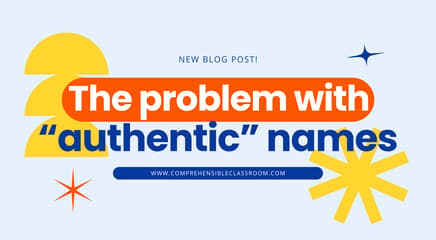Friday night's Skype with Dr. Hastings was fantastic! The only thing that could have made it better would be had my husband been available to watch the baby so that I didn't have to chase him around the room while we Skyped. Because of the little scoundrel, I couldn't take notes, so I'm just going off my memory and may have to add more to this post later as I remember it. It was most helpful to have him answer our questions about his method. Here were some of the points that stood out to me:
- Many of us were wondering what to do with dialogue. First of all, because Movie Talk is all about narrating "the visible", so it is important to choose films in which the plot can be understood well through narration of the scenes and actions of the characters. Dialogue should be NOT be described UNLESS it is essential to the understanding of the plot, and in that case it should be paraphrased and simplified as much as possible. Hastings even said that if students have a common first language, you could quickly translate the dialogue into (English, for example) and then move on describing what is visible.
- Hastings shows three minute clips of whatever film he is using, and then backtracks and Movie Talks it. We had some conversation about this after the Skype session was over. In my experience, students' attention span shrinks when they have seen the movie that I'm trying to Movie Talk. I think that I would prefer to Movie Talk a three minute segment first, and then backtrack and show the whole thing in one shot together.
- It's important to remember that Movie Talk is used almost exclusively in intensive university ESL programs (as part of FOCAL Skills). Typically, students must complete this program in order to begin their studies at a US University. Therefore, the age, motivation, and academic ability of the students is different and much more homogenous than we experience in our classrooms. Keep this in mind when reading about how Hastings and others use this technique. Movie Talk is used in the listening module, which is the first module that students complete in the program. Before they begin any reading, writing, or speaking, they listen to English primarily through Movie Talk until they are able to pass an assessment and move into the next module. Also, each session is four weeks long, and most students require 2-3 sessions before they are able to pass the assessment. New students enter every four weeks as other students graduate from the module, so there is a constant influx of "beginners". Movie Talk has proven successful for the multi-level dynamic that this creates, and so it is encouraging to think about its possibilities for those ever-pesky multi-level classes that we face.
- Storytelling or more traditional CI is a great way to pre-teach abstract vocabulary that is important to the understanding of the plot. This makes me think of Terry Waltz. She always reminds whoever is willing to listen that gesturing, pictures, etc. are not accurate nor by far the most effective means to communicate meaning. Michele showed us another cute Russian cartoon, and one of the vocabulary terms was "springtime". As much as she points at different things on the screen--trees blooming, baby animals, etc.--and says the word "springtime" in Russian, there is no way that all of her audience members will understand it correctly unless she just gives them the definition. If you want kids to know terms like that but want to stay in L2 during Movie Talk, then be sure to pre-teach it with a story or discussion! (I should clarify that Terry doesn't teach that gesturing is ineffective for abstract terms only, but for all terms. Even seemingly simple gestures, like 'eats', can be misunderstood, but kids should be able to understand most of the concrete terms pointed out to them through Movie Talk.)
I have been posting Movie Talk possibilities to my "Español" Board on Pinterest. Feel free to follow it, and please share links to any videos that you think would be good to Movie Talk.



